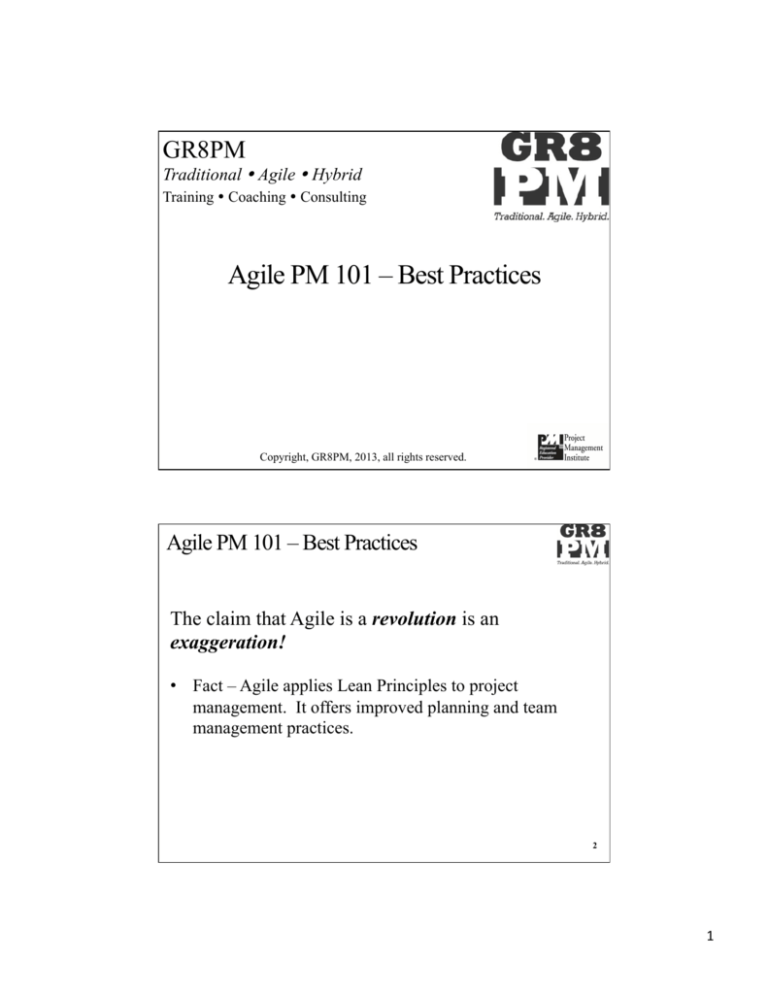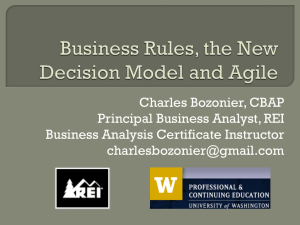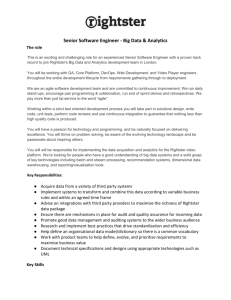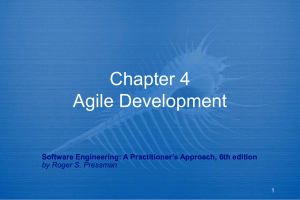
GR8PM
Traditional Agile Hybrid
Training Coaching Consulting
Agile PM 101 – Best Practices
Copyright, GR8PM, 2013, all rights reserved.
1
Agile PM 101 – Best Practices
The claim that Agile is a revolution is an
exaggeration!
• Fact – Agile applies Lean Principles to project
management. It offers improved planning and team
management practices.
2
1 Agile PM 101 – Best Practices
Every Agile framework is missing two key
components.
• Fact – Every Agile framework is missing budgeting and
sophisticated scheduling tools. The PMBOK® Guide
solves those problems and makes Agile better!
3
Agile PM 101 – Best Practices
Agile, as practiced by many agilists, ignores the
needs of the organizational-customer for estimating
and planning.
• Fact – Many Agilists ignore the proven scheme of ROM,
Budgetary, and Definitive estimates for reliable planning
that supports the organizational-customer. The PMBOK®
Guide solves that problem and makes Agile better
4
2 Agile PM 101 – Best Practices
None of those facts mean
I am against Agile!
Please let me introduce myself.
5
Introduction:
John Stenbeck, PMP, CSM, CSP, PMI-ACP
" Sr. PM Consultant for client-side
ERP implementations
" Past President and VP of Prof. Dev.
for PMI-SD
" Adjunct instructor at the University
of California San Diego (UCSD)
" Trains technical professionals in Aerospace,
Defense, High Technology, Financial Services,
Bio-medical and Life-science fields
6
3 GR8PM Introduction:
1st PMI-ACP
Exam Prep book,
published Jan. 2012
1st Agile
Government Contracting,
1st PMI-ACP &
CSP Prep book,
published June 2013
coming Oct. 2013
7
GR8PM Introduction:
" PMP® and PMI-ACP® Exam Prep classes
" Scrum Master Certification classes
" Corporate On-site seminars:
"
"
"
"
Command Course in Agile Project Management
Project Management Boot Camp
Crash Course in Leadership
Masters Course in Estimating and Risk Management
" Organizational Support Services:
" Agile Enterprise Roll-out Consulting
" Contract Project Managers
8
4 GR8PM Introduction:
Partial List of Past Clients
" Booz Allen Hamilton, Inc., McLean, VA
" Guinness Bass Import Company, Greenwich, CT
" Lucent Technologies – Bell Labs, Allentown, PA
" Nike Corp., Beaverton, OR
" Oracle Corp., Redwood Shores, CA
" Orange County Public Works, Orange, CA
" Qualcomm Inc., San Diego, CA
" U.S. Army – Space & Terrestrial Comms., Fort Monmouth, NJ
" U.S.D.A. – National Finance Center, New Orleans, LA
" Visa – Smart Cards, Foster City, CA
9
GR8PM
Traditional Agile Hybrid
Training Coaching Consulting
Agile PM 101 – Best Practices:
UNDERSTANDING THE ENVIRONMENT
10
5 Agile PM 101 – Best Practices:
UNDERSTANDING THE ENVIRONMENT
Are You Ready
For Some
Key Questions?
11
Agile PM 101 – Best Practices:
UNDERSTANDING THE ENVIRONMENT
Key Questions:
Is Agile Really Needed?
The last major tool recognized in the PMBOK (Second Edition)
was Critical Chain in 1997.
What has changed since then?
• Google launched in September, 1998
• The iPod was unveiled in October, 2001
• The BlackBerry “smartphone” was released in January, 2002
• NASA’s Phoenix lander extracted Martian ice in June, 2007
• The iPad was released in April, 2010
12
6 Agile PM 101 – Best Practices:
UNDERSTANDING THE ENVIRONMENT
Has Complexity Increased?
ali
ty
k
Customer
Satisfaction
Qu
E
TI
M
Tim
e
Ris
QUALITY
e
PMBOK® Guide,
Fourth Edition
ST
Guide,
Third Edition
op
Sc
CO
PMBOK®
Cost
Iron Triangle transformed into Hell-of-a-Hexagon
From Three to Fifteen Interrelationships. 13
Agile PM 101 – Best Practices:
UNDERSTANDING THE ENVIRONMENT
Is Agile Being Used?
14
7 Agile PM 101 – Best Practices:
UNDERSTANDING THE ENVIRONMENT
Who is using Agile?
15
Agile PM 101 – Best Practices:
UNDERSTANDING THE ENVIRONMENT
Organizations
16
8 Agile PM 101 – Best Practices:
UNDERSTANDING THE ENVIRONMENT
Certifications
PMI
SCRUM ALLIANCE
PgMP PMISP PMP ACP PMIRMP
CAPM 17
Agile PM 101 – Best Practices:
UNDERSTANDING THE ENVIRONMENT
PMI-ACP® fastest growing in PMI history!
18
9 GR8PM
Traditional Agile Hybrid
Training Coaching Consulting
Agile PM 101 – Best Practices:
ALIGNING WITH THE
PMBOK® Guide
Project Management Institute, A Guide to the Project Management Body of Knowledge,
(PMBOK® Guide) – Fifth Edition, Project Management Institute, Inc. 2012
19
Agile PM 101 – Best Practices:
ALIGNING WITH THE PMBOK® Guide
We Value…
Individuals and Interactions
Working Software
Customer Collaboration
Responding to Change
over
over
over
over
Processes and Tools
Comprehensive Documentation
Contract Negotiation
Following a Plan
We Would Add… not a …
20
10 Agile PM 101 – Best Practices:
ALIGNING WITH THE PMBOK® Guide
Similar Taxonomy for Each Methodology
Traditional:
Graphical WBS
DETAILS
Objective
Few &
Broad
Phase 1
Agile / Scrum:
Feature Structure
Product
Phase 2
Work
Package 1
Work
Package 2
Work
Package 1
Activity 1
Activity 2
Activity 3
Task 2
Task 1
Theme 1
Work
Package 2
Epic 1
Many &
Specific
Task 3
Theme 2
Epic 2
Epic 3
Epic 4
Story
1
Story
2
Story
3
Task 1
Task 2
Task 3
21
Agile PM 101 – Best Practices:
ALIGNING WITH THE PMBOK® Guide
Similar Taxonomy for Each Methodology
Definitions are completely arbitrary logical devices.
PMBOK:
AGILE:
1. Objective
1. Product 1. Business-level Full Function Vision
2. Phase
2. Theme
.
.
.
.
3. Work Pkg. 3. Epic
DEFINITION:
2. What a User Class wants to see or
experience (Sub-function; End-toend workflow)
.
.
3. What a User will do and the result(s)
they will see
4. Activity
4. Story
4. Workflow component in User words
5. Task
5. Task
5. Technical job plus acceptance
criteria
22
11 Agile PM 101 – Best Practices:
ALIGNING WITH THE PMBOK® Guide
Knowledge
Areas
Project
Management
Integration
Initiating
● Develop Project
Charter
Project Management Process Groups
Planning
Executing
M&C
● Develop Project
Management Plan
● Develop
Project Charter
Project
Management
Project
Scope
Integration
● Direct and Manage
Project Execution
● Develop
Project
Management
● Collect
Requirements Plan
● Monitor and
Control Project Work
● Perform
Integrated
Direct
and
Change Control
●
Manage Project
Execution
● Verify Scope
● Control Scope
● Define Scope
● Create WBS
Management
Fact – Integration Management
•
Project Time
Management
Project Cost
Management
● Define Activities
● Sequence
Activities
● Estimate Activity
Resources
● Estimate Activity
Duration
● Develop Schedule
● Control Schedule
● Estimate Cost
● Determine Budget
● Control Costs
● Monitor and
Control Project
Work
● Perform
Integrated
Change Control
● Close Project
or Phase
Integration, in the context of managing a project, is making
choices about where to concentrate resources and effort on any
given day, anticipating potential issues, dealing with these
issues before they become critical, and coordinating work for
the overall project good.
— PMBOK® Guide, Third Edition
● Plan Quality
•
Project
Quality
Management
Closing
● Close Project or
Phase
● Perform Quality
Assurance
● Perform Quality
Control
Integration management is a juggling act of trade-offs and
coordination as part of balancing the project execution and the
expectations of the stakeholders.
23
Agile PM 101 – Best Practices:
ALIGNING WITH THE PMBOK® Guide
Knowledge
Areas
Project
Management
Integration
Initiating
● Develop Project
Charter
Project
Scope
ProjectManagement
Scope
Management
Project Management Process Groups
Planning
Executing
M&C
● Develop Project
Management Plan
● Direct and Manage
Project Execution
● Collect
Requirements
● Define
● Collect
Scope
Requirements
● Define Scope
● Create
● Create WBS
WBS
Closing
● Monitor and
● Close Project or
Control Project Work
Phase
● Perform Integrated
● Verify
Change Control
Scope
● Control
● Verify Scope
● Control ScopeScope
Fact – Scope Management
Project Time
Management
Project Cost
Management
•
● Define Activities
● Sequence
Activities
● Estimate Activity
Resources
● Estimate Activity
Duration
● Develop Schedule
● Control Schedule
● Estimate Cost
● Determine Budget
● Control Costs
Project Scope Management includes the processes
required to ensure that the project includes all the work
required, and only the work required, to complete the
project successfully.
— PMBOK® Guide, Third Edition
● Plan Quality
Project
Quality
Management
● Perform Quality
Assurance
● Perform Quality
Control
Which is riskier, 2 critical paths or 1? Traditional fixes scope
and tries to control 2 variables - time and cost. Agile fixes
those two and controls 1 variable - scope.
24
12 Agile PM 101 – Best Practices:
ALIGNING WITH THE PMBOK® Guide
Knowledge
Areas
Initiating
● Develop Project
Charter
Project
Management
Integration
Project Time
Management
Project Scope
Management
Project Management Process Groups
Planning
Executing
M&C
● Develop Project
Management Plan
● Direct and Manage
Project Execution
● Define
Activities
● Sequence
● Collect
Activities
Requirements
● Define Scope
● Estimate
● Create WBS
Activity
Fact – Time Management
Project Time
Management
Project Cost
Management
•
Schedule
● Verify Scope
● Control Scope
● Define Activities
● Sequence
Activities
● Estimate Activity
Resources
● Estimate Activity
Duration
● Develop Schedule
● Control Schedule
● Estimate Cost
● Determine Budget
● Control Costs
Time management includes the processes required to
accomplish timely completion of the project.
— PMBOK® Guide, Third Edition
Using high-precision low-accuracy information to predict
dates or plan sets a project up for failure. Manage time by
forecasting instead of prediction.
● Plan Quality
Project
Quality
Management
Closing
● Monitor and
● Close Project or
Control Project Work
Phase
● Perform Integrated
● Control
Change Control
● Perform Quality
Assurance
● Perform Quality
Control
25
Agile PM 101 – Best Practices:
ALIGNING WITH THE PMBOK® Guide
Knowledge
Areas
Initiating
Project
Management
Integration
● Develop Project
Charter
Project Cost
Management
Project Scope
Management
Project Management Process Groups
Planning
Executing
M&C
● Develop Project
Management Plan
● Direct and Manage
Project Execution
● Collect
Requirements
● Define
● Collect
Scope
Requirements
● Define Scope
● Create
● Create WBS
WBS
Closing
● Monitor and
● Close Project or
Control Project Work
Phase
● Perform Integrated
● Verify
Change Control
Scope
● Control
● Verify Scope
● Control ScopeScope
Fact – Cost Management
•
Project Time
Management
Project Cost
Management
● Define Activities
● Sequence
Activities
● Estimate Activity
Resources
● Estimate Activity
Duration
● Develop Schedule
● Control Schedule
● Estimate Cost
● Determine Budget
● Control Costs
Project cost management includes the processes
involved in planning, estimating, budgeting and
controlling costs so that the project can be completed
within the approved budget.
— PMBOK® Guide, Third Edition
We cannot maximize business or customer value without
working closely with the customer. The goal of estimating
and budgeting – cost management – is to help the customer
select the best cost/performance trade-off.
● Plan Quality
● Perform Quality
Assurance
● Perform Quality
Control
Project
Quality
Management
26
13 Agile PM 101 – Best Practices:
ALIGNING WITH THE PMBOK® Guide
Knowledge
Areas
Project Management Process Groups
Planning
Executing
M&C
Initiating
Project
Management
Integration
● Develop Project
Charter
Project
Quality
Management
● Develop Project
Management Plan
● Plan
Quality
● Monitor and
● Close Project or
Control Project Work
Phase
● Perform
● Perform
● Perform Integrated
QualityChange ControlQuality
Assurance
Project Scope
Management
Closing
● Direct and Manage
Project Execution
Control
● Collect
Requirements
● Define Scope
● Create WBS
● Verify Scope
● Control Scope
● Define Activities
● Sequence
Activities
● Estimate Activity
Resources
● Estimate Activity
Duration
● Develop Schedule
● Control Schedule
● Estimate Cost
● Determine Budget
● Control Costs
Fact – Quality Management
•
Project Time
Management
Project Cost
Management
Project Quality Management processes include all the
activities of the performing organization that determine
quality policies, objectives, and responsibilities so that
the project will satisfy the needs for which it was
undertaken. — PMBOK® Guide, Third Edition
‘Quality’ is what the customer gets out and is willing to pay
Project for. Customers pay only for what is of use to them and gives
Quality
Managementthem value. Nothing else constitutes ‘quality'.
— Peter Drucker.
● Plan Quality
● Perform Quality
Assurance
● Perform Quality
Control
27
Agile PM 101 – Best Practices:
ALIGNING WITH THE PMBOK® Guide
Similar Roles
Traditional vs. Agile/Scrum
Traditional:
• Stakeholders & Sponsor
Agile / Scrum:
• Stakeholders & Sponsor
• Program or Sr. Project Manager
• Product Owner
• Jr. PM or Team Lead
• Scrum Master
• Team and SME’s
• Team and SME’s
• Everybody else
• Everybody else
28
14 GR8PM
Traditional Agile Hybrid
Training Coaching Consulting
Agile PM 101 – Best Practices:
UNDERSTANDING & APPLYING
AGILE
29
Agile PM 101 – Best Practices:
UNDERSTANDING & APPLYING AGILE
ESTIMATING
When is it best to do detailed estimating, (a) when you
know very little or (b) when you know a lot?
Waterfall
Agile
TIME
30
15 Agile PM 101 – Best Practices:
UNDERSTANDING & APPLYING AGILE
Fundamental Premise of Planning
% Design
Complete
0 – 10 %
15 – 25 %
45 – 100 %
Estimate Types
ROM
Budget
Definitive
Estimate
Accuracy
+100% to – 50%
+30% to – 15%
+15% to – 5%
31
Agile PM 101 – Best Practices:
UNDERSTANDING & APPLYING AGILE
WORK
DEFINITIVE /
BUDGETARY
ROM (SIZE)
TIME:
T
T+30
T+60
T+90
T+120
T+180
32
16 Agile PM 101 – Best Practices:
UNDERSTANDING & APPLYING AGILE
How is level-set planning and estimating done?
FEATURE USAGE
Feature Usage reported by Jim Johnson, Chairman, Standish Group Int’l, Inc.
XP2002 Conference, Sardinia, Italy
33
Agile PM 101 – Best Practices:
UNDERSTANDING & APPLYING AGILE
KEY QUESTION:
What is the PURPOSE of planning and estimating?
COST and RISK
VALUE of
ADDED INFORMATION
LAST
RESPONSIBLE
MOMENT
COST or RISK
of NOT DECIDING
TIME
Concept of Last Responsible Moment
34
17 Agile PM 101 – Best Practices:
UNDERSTANDING & APPLYING AGILE
Agile Program Planning Concepts
" Program Planning – Capacity (Velocity) Forecast
" 6 SME’s x 5 days x 4 weeks = 120 days
" 120 days x 60% efficiency = 72 days
" 72 days = Iteration Planning Limit
" Stories Durations:
"
"
"
"
"
Extra Small (XS) = 1 day
Small (S) = 2 days
Medium (M) = 3 days
Large (L) = 5 days
Extra Large (XL) = 8 days
35
Agile PM 101 – Best Practices:
UNDERSTANDING & APPLYING AGILE
Agile Program Planning Concepts
" Program Planning – Affinity Estimating
Smaller XS S M L XL PRIORITY
HIGH
Larger
LOW
36
18 Agile PM 101 – Best Practices:
UNDERSTANDING & APPLYING AGILE
Agile Program Planning Concepts
" Program / Release Planning
Roadmap – 1 Year
Release #1 – 6 Months
Feature
#1
Feature
#3
Feature
#2
Feature
#4
Feature
#4
Release #2 – 3 Months
Feature
#5
Feature
#6
Feature
#7
Feature Feature
#9
#8
Release #3 – 3 Months
Feature
#10
Feature
#11
Feature
#12
Feature
#6
Feature
#5
Feature
#3
Feature
#2
Feature
#1
MMF
BACKLOG:
Stories
1–N
37
Agile PM 101 – Best Practices:
UNDERSTANDING & APPLYING AGILE
Release #1 – First 4 Months
Iteration #1 – 4 Weeks
Stories
Stories
Stories
Iteration #2 – 4 Weeks
Stories
Iteration #1
ESTIMATE
Stories
Stories
Iteration #2
ESTIMATE
Iteration #3– 4 Weeks
Stories
Stories
Iteration #5 – 4 Weeks
Stories
Stories
Iteration #5
PLANNING POKER
Stories
Stories
Stories
Release #2 – First 2 Months
Iteration #6 – 4 Weeks
Stories
Iteration #4– 4 Weeks
Stories
Iteration #4
PLANNING POKER
Iteration #3
ESTIMATE
Release #1 – Final 2 Months
Stories
Stories
Stories
Iteration #6
PLANNING POKER
Iteration #7– 4 Weeks
Feature
Feature
Feature
Iteration #7
AFFINITY ESTIMATING
Iteration #8– 4 Weeks
Feature
Feature
Feature
Iteration #8
AFFINITY ESTIMATING
38
19 Agile PM 101 – Best Practices:
UNDERSTANDING & APPLYING AGILE
Agile’s Best Known Process
39
Agile PM 101 – Best Practices:
UNDERSTANDING & APPLYING AGILE
Iteration Cycle
CALENDAR – 4 WEEK ITERATION
MON.
TUES.
WEDS.
THURS.
FRI.
SPRINT
PLAN & BEGIN
STAND-UP &
WORK
STAND-UP &
WORK
STAND-UP &
WORK
STAND-UP &
WORK
STAND-UP &
WORK
STAND-UP &
WORK
STAND-UP &
WORK
STAND-UP &
WORK
STAND-UP &
WORK
STAND-UP &
WORK
STAND-UP &
WORK
STAND-UP &
WORK
STAND-UP &
WORK
STAND-UP &
WORK
PLANNING
POKER
STAND-UP &
WORK
STAND-UP &
WORK
STAND-UP &
WORK
REVIEW &
RETRO
SPRINT
PLAN & BEGIN
40
20 GR8PM
Traditional Agile Hybrid
Training Coaching Consulting
Agile PM 101 – Best Practices:
DRILLING DEEPER INTO AGILE
41
Agile PM 101 – Best Practices:
DRILLING DEEPER INTO AGILE
Similar Taxonomy for Each Methodology
Traditional:
Graphical WBS
DETAILS
Objective
Few &
Broad
Phase 1
Phase 2
Work
Package 1
Work
Package 2
Work
Package 1
Activity 1
Activity 2
Activity 3
Task 1
Task 2
Product
Theme 1
Work
Package 2
Task 3
Agile / Scrum:
Feature Structure
Epic 1
Many &
Specific
Theme 2
Epic 2
Epic 3
Epic 4
Story
1
Story
2
Story
3
Task 1
Task 2
Task 3
42
21 Agile PM 101 – Best Practices:
DRILLING DEEPER INTO AGILE
Level 1 - Product: iPad, v1.0, Web Access & Communication
Level 2 - Themes:
MANY
EPICS
• Video Watching
• Game Playing
• Music Listening
• Manage Contacts
• Create Messages
• Traveling
• E-Mailing
Level 3 – Epics (for E-Mailing):
• Store & Retrieve Messages
1 THEME
• Attach & Link Content
• Filter Viruses & Spam
43
Agile PM 101 – Best Practices:
DRILLING DEEPER INTO AGILE
Level 3 – Epics (for E-Mailing):
• Create Messages
• Manage Contacts
1 EPIC
• Store & Retrieve Messages
• Attach & Link Content
• Filter Viruses & Spam
MANY
STORIES
Level 4 – Stories:
• Create Contact
• Update Contact
• Delete Contact
• Sort Contacts
44
22 Agile PM 101 – Best Practices:
DRILLING DEEPER INTO AGILE
Level 4 – Stories:
• (Prior Slide)
ONE
STORY
MANY
TASKS
Level 5 – Tasks:
• Define Fields
• Define DB
• Define GUI
Does this remind you of
Progressive Elaboration and
Rolling Wave Planning?
• Check Duplicates
• Validate Format
• Import Function
45
Agile PM 101 – Best Practices:
DRILLING DEEPER INTO AGILE
User Story Descrip.on Priority As a: Size <Stakeholder or Role> I want to: <Requirement or Feature DescripMon> So that: <Reason or JusMficaMon> Acceptance Criteria Given: <Specific situaMon> When: <Specific acMon> Then: <Desired result > 46
23 Agile PM 101 – Best Practices:
DRILLING DEEPER INTO AGILE
User Story Descrip.on Priority As a: Size Email User I want to: Sort my emails So that: I can find emails from specific people Acceptance Criteria Given: I am logged into my email account When: I want to sort my emails Then: I can sort them by sender 47
Agile PM 101 – Best Practices:
DRILLING DEEPER INTO AGILE
Fibonacci Sizing & Planning Poker:
1. The Fibonacci series = 1, 2, 3, 5, 8, 13, 21, 34, 55…
• Defined by the non-linear recurrence equation: Fn = Fn-1 + Fn-2
2. Process first establishes a “midpoint” and then the relative
size of other items in the group
3. Leverages our physiological “wiring” because humans are
Pattern-based organisms!
3 5 8 13 21 34
1 2
55
Knowledge
Tr ansfer
Knowledge Transf
r
ansfer dge Transfe
er owled
Kn
& Career Skills& Caree
wle dge Tr Knowle
ge Tr ans
Kno
r Skills
fer
s Career Sk ills
fer
e Tr ans & C are er S kill &
www.PM8020.cwom
ww.PM 8020.com & Ca reer SkillsKno wle
owl edg
ls
sf er
om .P M8020. com
w ww .PM
dg
TranKn C are er S kil www.PM 8020 .cw ww
8020.com& Ca e Tr ansfer
&
ed ge
ree
om
K nowl ree r Sk ills mw.PM802 0.c
www .PM r SkillsK no
wled
ww
80 20 .co
& Ca 80 20.co
m & C ge Tr
PM
w.
ww
ww areer Sk ansfer
w. PM
ill
80 20 s
.com
48
24 Agile PM 101 – Best Practices:
DRILLING DEEPER INTO AGILE
Test Driven Development
PASS TEST; DEFINE NEXT TEST CREATE WELL-­‐
DEFINED TEST
TAKE TEST
FAIL TEST PASS TEST; DEFINE NEXT TEST DO SOMETHING
TAKE TEST
FAIL TEST ALL TESTS PASSED; DEVELOPMENT STOPS TDD PROCESS FLOW
49
Agile PM 101 – Best Practices:
DRILLING DEEPER INTO AGILE
Tracking Systems
50
25 Agile PM 101 – Best Practices:
DRILLING DEEPER INTO AGILE
Typical Burndown Report
51
Agile PM 101 – Best Practices:
DRILLING DEEPER INTO AGILE
Baseline;
Planned Value
EVM & Burn-up
Chart
Work Completed
Actual Cost
Stories Completed
Earned Value
Stories Completed
Earned Value
Actual Cost
1 2 3 4 5 6 7 8 9 10 11 12 13 14 15
Days
52
26 Agile PM 101 – Best Practices:
DRILLING DEEPER INTO AGILE
Implications for Project Leaders
TOTAL PROJECTS BY FRAMEWORK
53
GR8PM
Traditional Agile Hybrid
Training Coaching Consulting
THE SIX PHASES
OF A PROJECT
1. Enthusiasm
2. Disillusionment
3. Panic
4. Search for the Guilty
5. Punishment of the Innocent.
6. Praise & Honor for the
Non-participants.
54
27










